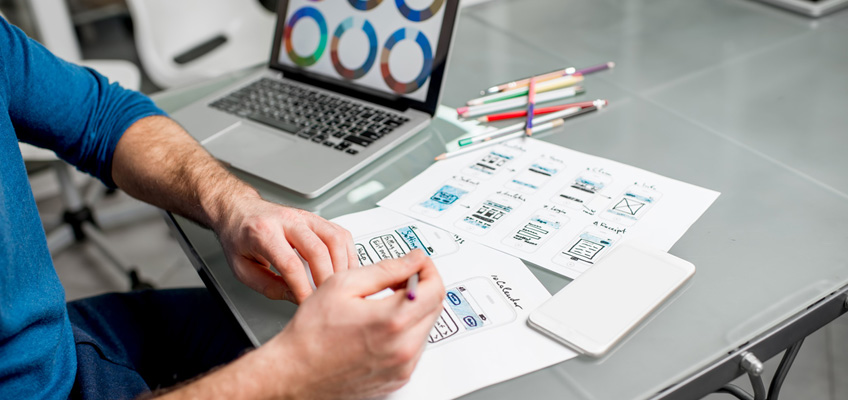
Here at Agent Image, design is not just about looking good; it’s more about creating something that works. From catching your target audience’s attention, to keeping them engaged with your content, all the way to turning them into leads that generate new business — all these are essential to a well-designed agent website.
Learning design begins with understanding the terms and concepts commonly used in this field. To help you along your website design journey with Agent Image, here are some basic words and phrases to remember:

-
Above/Below the Fold — “Fold” carries over from newspaper design terminology, referring to the top and bottom halves of a broadsheet. In website design, content “above the fold” refers to all elements that appear onscreen as soon as the page loads, whereas “below the fold” are those that appear immediately below.
-
Alignment — The positioning of elements like text, images, and icons in a webpage layout. Alignment not only affects the readability of content, but also its aesthetic presentation. Seasoned designers can use creative alignments to package information in innovative ways.
-
Backlink — These are links found on other websites that lead users to your own. You can create backlinks when you contribute to a colleague’s blog or an online publication. Backlinks help boost your website’s SEO results, especially if the platform you submitted to is a high-ranking one.
-
Bandwidth — Bandwidth refers to either (a) the speed or rate at which data is transferred online or (b) the amount of data that can be transferred from a web host in a given period. In both senses of the term, high bandwidth connections allow more content to be accessed through both better speeds and more data allocation.
-
Bounce Rate — The percentage of users that leave a website without clicking through to other pages. High bounce rates are red flags that suggest that either (a) the navigation of the website or (b) the quality of its content needs to be improved.
-
Browser — This refers to the programs or apps used to view websites. Programs like Google Chrome, Mozilla Firefox, Safari, Opera, and Microsoft Edge are internet browsers.
-
Call-to-action (CTA) — In website design, CTAs invite users to make a particular action. CTAs are important lead generation tools. These can be as simple as a “Read More” link on a homepage blurb leading to a more detailed page inside the website. Not limited to buttons, they can also be more strategically crafted to suit a product’s relevance, such as Evernote’s “Remember Everything” blurb, or to distinguish between different offers, such as Spotify’s differently colored free and premium CTA buttons.
-
Clickthrough Rate (CTR) — The percentage of website visitors that lingers and advances onto another part of your website, specifically to pages and features tied into a marketing action or campaign. The CTR is a reliable indicator of the level of engagement users have on your website, as well as the effectiveness of your calls-to-action.
-
Color Palette/Scheme — The combination of colors used throughout the entire website. Color palettes lend a unifying theme across different pages in a website, helping create a distinctive identity and brand recall.
-
Domain — Essentially, a website’s name. Domains are composed of a combination of letters, numbers, and occasionally hyphens and end with an extension, such as .com, .org, and .net.
-
Favicon — Small icons that appear beside the website name on a browser tab. These icons are customizable and may be used to display a logo to boost brand identity and recall.
-
Fixed Header — A bar that is always visible to website users even as they continue scrolling down a page. Fixed headers keep main navigation links accessible, making sure that users can click on them any time they need to.
-
Focal Point — A central item or area where a viewer’s eye is drawn to on a website. Good web design involves knowing which parts of the website should demand the user’s focus, whether it’s a piece of content or a call-to-action.
-
Grid — In website layouts, grids are a series of intersecting vertical and horizontal lines that provide a structure to organizing content on a webpage. Grids guide designers in aligning and organizing content so that they are visually appealing and easy to absorb.
-
Landing Page — This is the first webpage that users see when they enter a website. Landing pages can be creatively structured to encourage a specific marketing action or further engagement with more content throughout the website.
-
Mobile Optimization — This refers to designing a website such that it performs on mobile devices as well as it does on a desktop computer. This typically involves a responsive website design that automatically adjusts to narrower screen resolutions, such as mobile phones’ and tablets’ portrait-oriented displays, while retaining all of the content.

-
Navigation — In design terms, this refers to the system that enables users to move around a website from one location to another. Website navigation elements include menus, links, buttons, pagination, and other similar elements.
-
Negative/White Space — The empty space that surrounds certain elements of a design. Negative space is just as important in website design as the content or information placed on a webpage. Empty spaces enable better readability and prevent users from being overwhelmed by too much clutter on any given page.
-
Pixel — This refers to the smallest element of a digital image. As dots per inch (dpi) or pixels per inch (ppi), pixels also serve as a unit of measure that determines how an element will look on a webpage layout.
-
Serif — In typography, this refers to the small line or projection at the end of a stroke of a letter. Times New Roman, Garamond, and Baskerville are common examples of serif typefaces, whereas Arial, Calibri, and Helvetica are sans serif typefaces.
-
Type/Typeface — A collection of letters, numbers, punctuations, and other characters in varying designs. Typeface can also be referred to as a “font family” and may appear in a variety of font sizes and styles, such as bold, italicized, condensed, or light.
-
Responsive Design — In website design, this is the practice of enabling a website to recognize and automatically adapt to the display on which it is being viewed. A responsive website’s typical horizontal or landscape view on a desktop computer will appear in a different view that is better suited for a portrait or vertically-oriented tablet or mobile phone screen.
-
URL — Short for ”Uniform Resource Locator,” this term refers to the address that users type into their browsers to access a website or specific sections of any website.
-
User Experience — This refers to all aspects of a user’s interaction and engagement with a website, from discovery and access, to ease of use, to their response to specific CTAs as well as their feedback. User experience should be a primary consideration when embarking on any website design project.
-
User Interface — This refers to the set of controls and actions that enable users to experience and interact with a website and its contents. User interfaces include elements like menus and toolbars, buttons, windows and tabs, and the like.
There’s more excitement in being part of the design process than just seeing the final product. Start building a new bank of knowledge with this preliminary design glossary and get ready to discover more as you partner with Agent Image.
Let’s get started today. Call 800.979.5799 for your free consultation with our design experts and marketing strategists. Soon you’ll be on your way to a path towards greater success — equipped with a strong website designed to excel in today’s dynamic, interactive, and highly competitive internet-powered market.
.postid-12703 ol li{
font-weight: bold;
font-size: 0.938em;
}
The post Defining Design: A Glossary of Website Design Terms You Should Know appeared first on Best Real Estate Websites for Agents and Brokers.
Your article is incredibly useful.Everyday your diary inspire Pine Tree State heaps deal and helped to develop one thing new like I actually have developed a brand new app spotify premium free android apk this is often great and pleasant.Thanks for the awe-inspiring posts , please keep updated frequently.
ReplyDeleteHi This is SRK i'm suggesting you this is app DraStic DS Emulator Mod Apk (Licence Resolved)
ReplyDelete